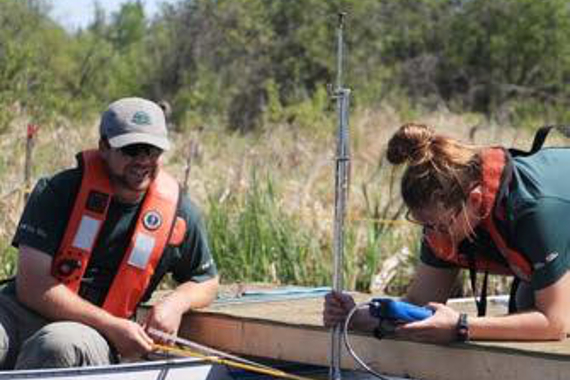
Parks Canada staff test a Clear Lake water sample for the presence of invasive zebra mussels. Photo: © Chantal Skraba
Keeping it clear
Restoring Clear Lake in Riding Mountain National Park
What’s the issue?

When Riding Mountain National Park was established in 1933, society had a different perspective on how parks should be managed. In those days, the focus was on creating access and recreation for people, with little regard to the impact on ecosystems – including Clear Lake, a park centerpiece. Consequently, lakeshores were lined with cottages and roads, vegetation was cleared and boat ramps installed, wastewater effluent flowed, and connections with surrounding wetlands simplified. Clear Lake suffered. Aquatic habitats were lost, fish populations declined, water quality was jeopardized and invasive species loomed nearby. The modern view on park management means taking preventative action and restoring ecosystems where possible. So, park staff have embarked on an ambitious plan to clear up Clear Lake.
What’s our approach?
- Collaborate with Keeseekoowenin Ojibway First Nation (KOFN) on a cooperative management agreement; bring awareness of the issues to all lake users and adjacent municipalities.
- Work with Clear Lake Golf Course to rehabilitate 3 hectares of Bogey Creek.
- Engage universities to improve understanding of water flow, nutrient inputs and water budgets; identify options to restore the linkage with South Lake.
- Prevent the establishment of invasive zebra mussels by educating visitors, inspecting boats prior to launch, and monitoring for early detection.
What’s been accomplished?
- KOFN shared Indigenous knowledge about the whitefish and northern pike populations, helping to establish ecosystem health targets.
- Strengthened support from stakeholders and stewardship action outside the park; neighbours upgraded their waste disposal systems.
- Restored 3.78 hectares along Bogey Creek by cleaning up waste material at Grey Owl dump, re-contoured slopes, and re-vegetated the shoreline in day-use areas.
- Partnered with local universities to research restoring connections between Clear Lake, South Lake and Octopus Creek.
- Improved Boat Cove launch facilities; conducted 10,000 boat inspections for aquatic invasive species; decontaminated more than 500 vessels and monitored for zebra mussels.
- Date modified :